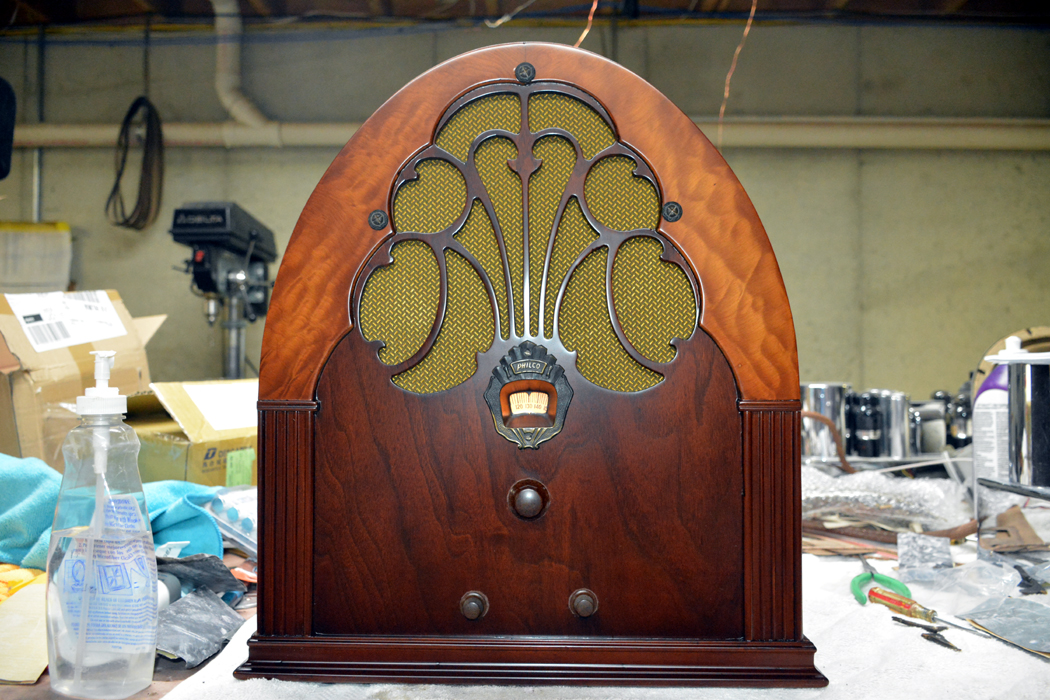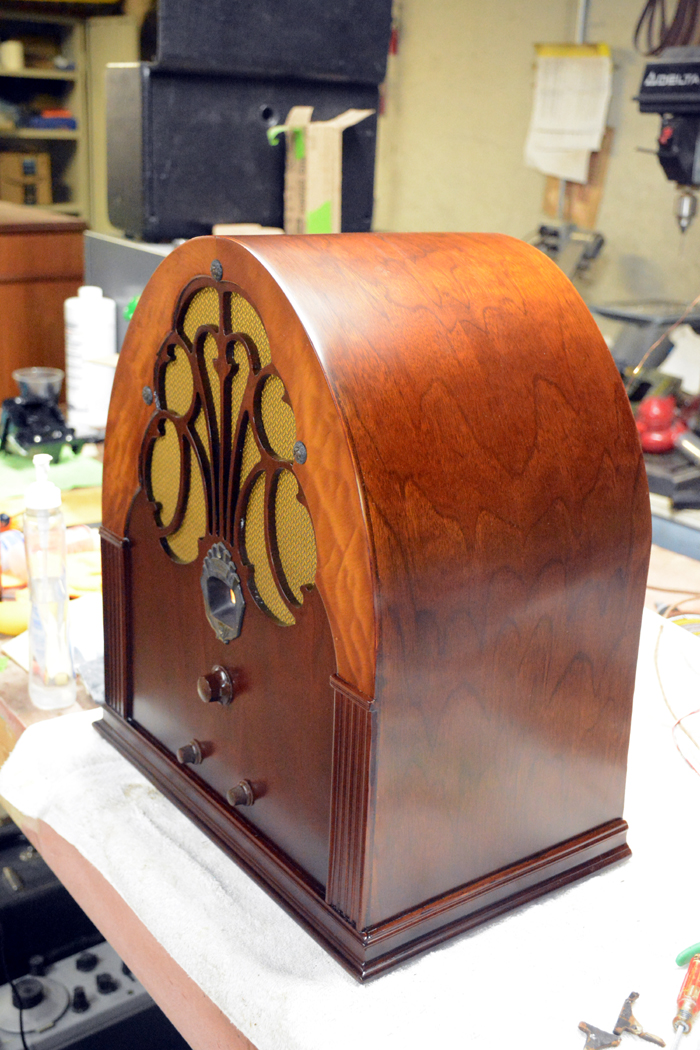Posts: 4,334
Threads: 407
Joined: Jun 2011
City: Boston
State, Province, Country: Massachusetts
Getting off topic from the Swell Philco Rob did, and while the finish is frustrating these things happen, sometimes you figure why sometimes not.
I had an RCA a friend finished for me, was great then got a small white hazy area, maybe a polish I used, maybe some moisture cooked up from underneath lacquer, who knows? To make it even better the cat then scrabbled all over the tp panel to scratch it up nice too. Still plays well....... 
We had a fellow in our club do a presentation on Curtain Burners, if you got the time......
https://www.youtube.com/watch?v=Bs-mKnwLtLM&t=670s
Paul
Tubetalk1
Posts: 15,307
Threads: 532
Joined: Oct 2011
City: Jackson, NJ
Cats give radios character.
People who do not drink, do not smoke, do not eat red meat will one day feel really stupid lying there and dying from nothing.
Posts: 1,181
Threads: 48
Joined: Oct 2017
City: Allendale, MI
Okay. Done, I think. Stripped the cabinet again and refinished again. this time I hope it won't develop the cracks in the lacquer.
The radio has a great lack of sensitivity on the low end of the dial compared to the high end. I suspect it may be because of the re-winding of 2 of the RF coils. Not sure I will investigate as I really don't like the sound of the radio even with a good signal. At least I can demonstrate that it works and looks reasonable.


Posts: 15,307
Threads: 532
Joined: Oct 2011
City: Jackson, NJ
Rob
It looks just great!
And to me personally, radios like Philco 20, and for that matter also 70 are not to be listened to today, but to be demonstrated: "See? This is 20 and it works!".
The plate detector is not exactly a high fidelity way of playing music.
People who do not drink, do not smoke, do not eat red meat will one day feel really stupid lying there and dying from nothing.
(This post was last modified: 03-19-2021, 02:36 PM by morzh.)
Posts: 1,181
Threads: 48
Joined: Oct 2017
City: Allendale, MI
Yup, more for looks, less for sound. I never listen to my 70. I'm kinda into my EH Scott's right now, though I'll still crank up the 37-116. It actually sounds very good even next to the Philharmonics.
Posts: 15,307
Threads: 532
Joined: Oct 2011
City: Jackson, NJ
I doubt Philharmonic sounds whole lot better than 37-116 as a radio.
If used as an amp - maybe a bit.
People who do not drink, do not smoke, do not eat red meat will one day feel really stupid lying there and dying from nothing.
Posts: 1,181
Threads: 48
Joined: Oct 2017
City: Allendale, MI
The tweeters add a bit of "shimmer" on the Phillies. Cymbals sound better on the Phillies. The 37-116 and 38-116 are darn good radios! I should get my 38-690 going to see how that sounds next to the Scotts. It will probably be the next project.
Posts: 15,307
Threads: 532
Joined: Oct 2011
City: Jackson, NJ
Rob
37/38-116 have no tweeters. Unless you mean the passive radiators?
37/38-690 do.
People who do not drink, do not smoke, do not eat red meat will one day feel really stupid lying there and dying from nothing.
(This post was last modified: 03-19-2021, 11:12 PM by morzh.)
Posts: 1,181
Threads: 48
Joined: Oct 2017
City: Allendale, MI
Correct. I need to see how the 38-690 (with tweeters) sounds next to the Scotts (with tweeters). The 37/38-116's sound very good without tweeters, though.
Posts: 15,307
Threads: 532
Joined: Oct 2011
City: Jackson, NJ
Truth be told, when I put larger cap to the tweeters (and I did check the wiring - they were NOT counter-phased and I could hear them), I did not notice much difference in sound. The main speaker in these radios is surprisingly good and I am not sure it really requires tweeters. 37-116 does well without them.
People who do not drink, do not smoke, do not eat red meat will one day feel really stupid lying there and dying from nothing.
Posts: 4,612
Threads: 51
Joined: Sep 2008
City: Sandwick, BC, CA
The early "Baby Grand" line of sets sound muddy, in part because of the solid spider they used in the pie pan speakers, when they are reconed, or the original spider substituted with one of the 45 RPM adapters style spiders they usually sound much better. With regard to the detector, it might be worth an experiment substituting a S.S signal diode, or Schottky diode, for the plate detector, though most of us we usually have multiple choices of radio to listen to as a daily driver. I've also heard of some people swapping tubes, but that usually involves changing sockets, and I would not want to do this with a radio in good original condition.
Regards
Arran
Posts: 15,307
Threads: 532
Joined: Oct 2011
City: Jackson, NJ
I followed that article with research on plate detector.
It could be an ok thing to use if the feedback cap in the cathode is really brought down in value.
Indeed it made the sound much better. At the same time it lost gain.
Another amp stage after it and with 45 rpm spider it would make a decent sounding set.
A diode would do about the same. The gain would be gone.
People who do not drink, do not smoke, do not eat red meat will one day feel really stupid lying there and dying from nothing.
(This post was last modified: 04-02-2021, 07:21 PM by morzh.)
Posts: 855
Threads: 8
Joined: Jul 2020
City: Greenlawn
State, Province, Country: NY
Nice looking already, it is gonna be really nice when you finish it! That one has good bones!!
I bought a 20 piecemeal The chassis for$30, a poor but usable cabinet for another $30, have a fresh modern 8" speaker and a resistor replacing the field coil. (The correct speaker is too much $$on ePay and too much competition from other 20 restorers (and restorers of other models that use that speaker Was not impressed with the sound of one that I worked on.
Upped the size of the filters. Have to Try Ron's mod to cap couple the 27 plate to the interstage xformer. I will then try to put audio straight in, I bet it is sweet! Have been too busy with other stuff.
Re the finish of the chassis, I don't know if the grey finish is paint or plating. I have been a fan of Naval Jelly on rusted chassis that are not plated or where the plating is too gone but many of you are real experts (Phlogiston, your Zenith chassis re-plate jobs were awesome!!!) Someone had an article somewhere on how to remove the coil cans on this chassis but I don't remember who or how.
OOPS!! As usual, I didn't see the end of the thread. Fantastic job!! The thing is gorgeou!.
"Do Justly, love Mercy and walk humbly with your God"- Micah 6:8
Best Regards,
MrFixr55
(This post was last modified: 04-02-2021, 07:17 PM by MrFixr55.
Edit Reason: Didn't see later threads.
)
Posts: 1,181
Threads: 48
Joined: Oct 2017
City: Allendale, MI
Thank you! So far, the finish has not cracked on the re-do. I suspect that on the first time around, I didn't leave enough time between coats of lacquer. Also, I used instrument lacquer instead of regular lacquer until the final 2 coats of semi gloss. It is supposed to be more flexible. I also tried to get it closer to the original finish. Notice the slight shading near the "columns". This is what the original finish had (look at the photos of the original radio condition - post 1.) Accomplished by not masking off the front while toning the columns. Toner overspray darkens the front panel ever so slightly near the columns and the front panel along the bottom molding. Also notice on the original photo how the light colored arch is slightly toned on the inside edge near the grille filigree and the outside edge. Again, I tried to accomplish the same thing with very fine application of toner. I mixed my own toner and used the HVLP turned WAY down with no fan pattern to carefully tone those areas. I keep learning!!! Someday, maybe I'll catch up to Russ and Fred.
(This post was last modified: 04-03-2021, 11:32 AM by rfeenstra.)
Posts: 1,824
Threads: 114
Joined: Jul 2014
City: Sneedville, TN
RF, I have repaired and made violins for years. Modern instrument lacquers that come in spray cans are not suitable for violin work as they DO become too hard and brittle. No good violin has a lacquer finish, just the cheap ones. Good violins are finished with oil based varnish. I make my own from linseed oil, pure gum spirits of turpentine, pure grain alcohol, and amber, using a modification of an old recipe I found in an old violin making book that was given to me by an elderly friend, now deceased. This is why I have chosen to use tung oil varnish when restoring radios. It must be rubbed on in very thin coats by hand, coat after coat, but it remains flexible after it dries, and is very water resistant and durable. Tung oil is also an excellent varnish to use for instruments because of this. You can color these varnishes by mixing in a little artists' oil paint, using one of the CLEAR colors, not the opaque colors, so you need to read up on your artists' oil paints too. If you do color them, it will slow down the drying process. Tung oil dries fairly quickly, in a couple of days per coat. My own varnish can take a week or three depending on the weather. LOL !
[Image: https://64.media.tumblr.com/52605070d7d4...1_1280.jpg]
Two of my violins drying in the sun back at my old house in RI.
Users browsing this thread: 3 Guest(s)
|




